A Deep Dive into the 3 Most Common Customs Clearance Mistakes (and How to Prevent Them)
The customs checkpoint is like the strictest gatekeeper in the world of trade. This gatekeeper doesn’t care about your urgent deadlines or your client’s expectations; they only care about one thing: accuracy. A single misplaced number or a mismatched document can bring your entire shipment to a grinding halt. While it may seem intimidating, navigating this process doesn’t have to be a source of stress. The key is knowing where the common pitfalls are. Let’s dive into the three most common-and costly-mistakes we see in customs clearance, and more importantly, how you can prevent them.
In the world of customs, a tiny clerical error on paper can become a massive, costly delay at the port. Preparation isn't just important-it's everything.

1. The Secret Code War: Incorrect HS Code Classification
The Mistake: The Harmonized System (HS) Code is a universal code that classifies your product. Misclassifying your product-even by accident-is the number one mistake businesses make.
The Consequence: An incorrect HS Code leads to paying the wrong amount of import duty. If you overpay, you lose money. If you underpay, you face fines, shipment seizures, and audits for being non-compliant. It’s a lose-lose situation.
How to Prevent It: Never guess. Always verify the HS Code using official government tariff databases or consult with a customs specialist. An expert can help you identify the correct code down to the last digit, saving you from this massive headache.
2. The “Three Siblings” Who Never Talk: Mismatched Documents
The Mistake: The three core shipping documents-Commercial Invoice, Packing List, and Bill of Lading (B/L) or Air Waybill (AWB)-must tell the exact same story. Often, businesses make small updates on one document but forget to correct the others.
The Consequence: To a customs officer, any inconsistency is a major red flag. A different weight on the Packing List versus the B/L, or a different quantity on the Invoice, signals a potential problem. This almost always leads to a physical inspection, causing significant delays and extra costs.
How to Prevent It: Treat these documents as one single truth. Before submission, have a meticulous checklist to ensure the shipper, consignee, cargo description, quantity, weight, and dimensions are identical across all three. A professional forwarder will do this as a standard procedure.
3. The “Low-Price Trap”: Incorrect Product Valuation
The Mistake: Intentionally declaring a lower value for your goods to pay less import duty.
The Consequence: This is the most serious mistake. Customs authorities have extensive databases of market values for virtually every product. If your declared value is suspiciously low, they will not only reject it but may also impose severe penalties for what they consider attempted fraud. This can damage your company’s reputation and get you blacklisted for future shipments.
How to Prevent It: Always declare the true, fair transaction value of your goods. Keep all proof of payment and commercial agreements ready. A trustworthy logistics partner will never recommend or engage in undervaluation; they will protect you by ensuring your declarations are always compliant and defensible.
Customs clearance can feel like navigating a minefield, but it doesn’t have to be. By understanding these common mistakes-related to Classification, Consistency, and Valuation-you are already one step ahead. The best way to prevent these issues is not just to be careful, but to have an expert partner who navigates this world every single day. At SEL Logistics, we act as your guide and your safeguard, ensuring your journey through customs is always smooth and secure.



